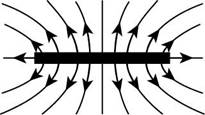
Concept explainers
A negatively charged rod of finite length carries charge with a uniform charge per unit length. Sketch the electric field lines in a plane containing the rod.
To draw: The electric field lines in a plane containing the rod.
Answer to Problem 1P
The diagram of electric field lines in a plane containing the rod is

Figure (1)
Explanation of Solution
Introduction:
Field lines represent a uniform electric field penetrating a plane of the area perpendicular to the field. The electric field is a vector field around a charged particle. It represents the force that other charged particles would feel if placed near the particle creating the electric field.
If the charge is positive, field lines points radially away from the rod; if the charge is negative, field lines points radially towards the rod. As the charge is negative, the field lines points radially towards the rod.
The diagram below shows the electric field lines in a plane containing the rod

Want to see more full solutions like this?
Chapter 23 Solutions
Physics for Scientists and Engineers with Modern Physics
Additional Science Textbook Solutions
Human Anatomy & Physiology (2nd Edition)
Campbell Essential Biology with Physiology (5th Edition)
Fundamentals Of Thermodynamics
Chemistry: Atoms First
Biology: Life on Earth (11th Edition)
 Principles of Physics: A Calculus-Based TextPhysicsISBN:9781133104261Author:Raymond A. Serway, John W. JewettPublisher:Cengage Learning
Principles of Physics: A Calculus-Based TextPhysicsISBN:9781133104261Author:Raymond A. Serway, John W. JewettPublisher:Cengage Learning Physics for Scientists and Engineers: Foundations...PhysicsISBN:9781133939146Author:Katz, Debora M.Publisher:Cengage Learning
Physics for Scientists and Engineers: Foundations...PhysicsISBN:9781133939146Author:Katz, Debora M.Publisher:Cengage Learning Physics for Scientists and EngineersPhysicsISBN:9781337553278Author:Raymond A. Serway, John W. JewettPublisher:Cengage Learning
Physics for Scientists and EngineersPhysicsISBN:9781337553278Author:Raymond A. Serway, John W. JewettPublisher:Cengage Learning Physics for Scientists and Engineers, Technology ...PhysicsISBN:9781305116399Author:Raymond A. Serway, John W. JewettPublisher:Cengage Learning
Physics for Scientists and Engineers, Technology ...PhysicsISBN:9781305116399Author:Raymond A. Serway, John W. JewettPublisher:Cengage Learning College PhysicsPhysicsISBN:9781305952300Author:Raymond A. Serway, Chris VuillePublisher:Cengage Learning
College PhysicsPhysicsISBN:9781305952300Author:Raymond A. Serway, Chris VuillePublisher:Cengage Learning Physics for Scientists and Engineers with Modern ...PhysicsISBN:9781337553292Author:Raymond A. Serway, John W. JewettPublisher:Cengage Learning
Physics for Scientists and Engineers with Modern ...PhysicsISBN:9781337553292Author:Raymond A. Serway, John W. JewettPublisher:Cengage Learning





